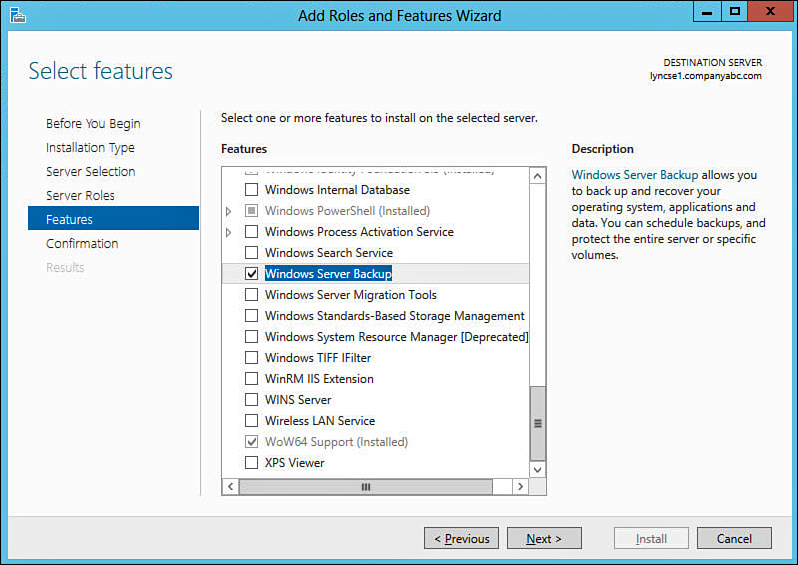SQL Backup Procedures
The new high-availability features of Lync
Server 2013 present new considerations for the backup of Lync Server
data as well. For example, the Front End Pool Pairing feature includes
the Lync Server Backup Service, which synchronizes the Lync Back End
databases between two Front End pools, including the Central Management
Store. For this reason, with some Lync Server
2013 topologies individual backups of SQL databases can be diminished
in importance in comparison with previous versions of the product.
However, there are still circumstances in which it makes sense to
perform a manual backup of the Lync SQL databases. For example, it is
always recommended to perform a backup before performing major
configuration changes. With that in mind, it makes sense to be familiar
with the options for performing this type of backup.
There are actually a number of ways to back
up the Lync SQL databases, including native Windows Server backup,
SQL-based backups that output the data into a flat file, and
third-party backup solutions that support SQL. In the following
sections, two methods of backing up the Lync Back End databases are
detailed, including Windows Server native backup and SQL 2012 native
backup.
Backing Up SQL Using Windows Server Native Backup
Windows Server 2008 R2 and Windows Server
2012 contain a native backup application called Windows Server Backup.
The sample backup procedure that follows is based on Windows Server
2012; however, the steps are very similar for Windows Server 2008 R2.
Because Windows Server Backup is not installed by default, it is
necessary to add this feature by performing the following steps:
1. From the Server Manager console, select Local Server in the left pane.
2. From the Manage drop-down menu, click Add Roles and Features.
3. At the Select Installation Type screen, keep the default option of Role-Based or Feature-Based Installation, and click Next.
4. At the Select
destination server screen, keep the default option of Select a Server
from the Server Pool, and verify that the Lync database server is
selected in the Server Pool list at the bottom of the screen. Click
Next.
5. At the Select Server Roles screen, click Next.
6. At the Select Features screen, scroll down to the bottom of the list of features and select Windows Server Backup, as shown in Figure 1. Click Next.

Figure 1. Adding the Windows Server Backup feature.
7. At the Confirm Installation Selections screen, click Install.
8. When the installation has completed, click Close.
Now that the Windows Server Backup feature is installed, it can be used to back up SQL using the following procedure:
1. From the Server Manager console, select Local Server in the left pane.
2. From the Tools drop-down menu, click Windows Server Backup.
3. In the Action pane at the far right, click Backup Once.
4. In the Backup
Options Wizard, either select Scheduled Backup Options to use
previously configured backup settings, or select Different Options to
make a backup with new options. Click Next.
Note
If this is the first time that Windows Server
Backup is being used, the Scheduled Backup Options selection will not
be available.
5. At the Select
Backup Configuration screen, choose either Full Server or Custom
Backup. If Custom Backup is selected, be sure that all volumes
containing SQL program files and data are included in the backup item
selections. For Lync Server SQL backup purposes, Full Server backup is
typically the best choice. After the selection is made, click Next.
6. At the Specify
Destination Type screen, select either Local Drives to store the backup
file locally, or Remote Shared Folder to store the backup file on the
network. Click Next.
Note
Windows Server Backup will only allow backups
to be targeted to drive volumes that are not selected as part of the
backup job. Therefore, unless an external disk is attached to the
system that can be used as a target, the Remote Shared Folder option is
typically the best choice for destination type.
7. Depending on the
selection made on the preceding screen, either the Select Backup
Destination screen or the Specify Remote Folder screen is presented.
For a local backup destination, choose an
available drive volume from the drop-down menu and select whether
backup verification will be enabled after the backup file is written.
For a remote folder, specify the remote location using the UNC path
format, as shown in Figure 2;
then in the Access Control section select whether access to the backup
file will require credentials. When finished, click Next, which will
validate the backup destination.

Figure 2. Remote folder backup settings.
8. After the backup
destination is validated, review the backup job settings listed on the
Confirmation screen, and then click Backup to begin the backup job.
9. After the backup job completes, click Close.